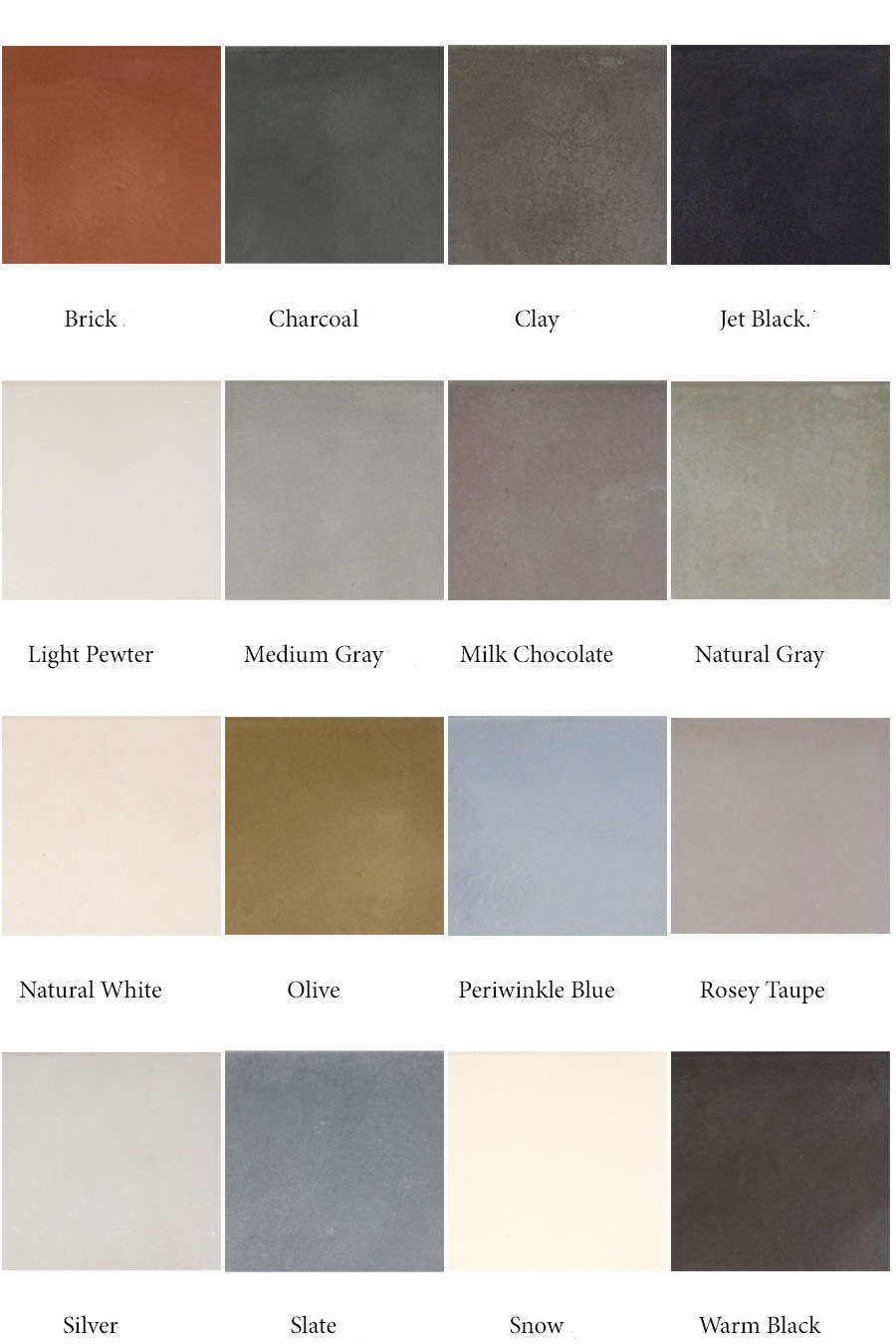Concrete is not a homogenous, uniform material. Just like natural wood or stone, the finished concrete's appearance can have subtle aesthetic variations of shade, color or pattern, depending on the materials used, the casting and curing process and the processing and finishing techniques. Concrete will sometimes have natural voids that occur during casting. These are generally filled with a matching color of the entire piece but will always be subtly different.
Concrete is a natural, handmade material. Many factors such as humidity, sand lot and cement lot can affect the final appearance of the concrete. Even if color formulas record the type of sand, type of cement, and exact measurements of pigments to 1/10th of a gram, colors can still vary because of the aforementioned factors.
Variation, especially color and visual texture, almost always occur to some degree or another. The greatest degree of variation is often seen between old samples and newly finished concrete, because the ingredients used were not identical. However, if carefully executed, all of the concrete within a particular job should look the same, even if the final work looked subtly different from the sample. In other words, all of the variations will be similar so that the finished product looks alike.
Another factor that contributes to perceived variation is simply the size of samples. A 10” x 10” sample, or even a 12” x 12” sample, will look different than a whole finished piece simply because the small sample does not capture all of the natural, random variations that will occur over a large surface. The color in a 10” x10” sample may appear completely uniform, but a whole piece in that exact same color will not appear as uniform. The same situation occurs with other natural materials such as granite. If you prefer perfect uniformity, a solid surface might be a better countertop option.
Seams for precast concrete are sometimes located around sinks and cooktops, or wherever required for structural reasons. We will work with you to design seam placement that is both structurally sound and aesthetically pleasing. They can also be used as a design element in the finished piece.
Seams are approximately 1/8” wide, similar to tile grout lines. However, it is important to realize that our concrete creations are hand made and hand processed; they are not machine cut, so tolerances for seams can be more generous than with granite. Seam appearance is minimized by using color-matched caulk or epoxy.
Although precast concrete are one of the last items to be installed, concrete designs should be selected as early as possible. Here is an outline of the process:
1. Templating from finished cabinetry/structure(1 day)
Templating is done from finished and installed cabinetry/structure, and it takes less than one day. This is exactly the same as the process for granite.
2. Creation/Fabrication (5-6 weeks)
The typical time required to craft most concrete pieces, depending on their size and complexity, is 5-6 weeks. Note that the actual creation process may not start immediately after templating depending on how full our production schedule is. A good guideline is to contact us at the beginning of the project, or at the latest one month before cabinetry/structure is scheduled to be installed, both to allow time for custom color samples and to secure a spot on the production schedule.
3. Delivery & Installation (1-2day)
Depending on the size of your project, your location and installation site characteristics this process can take two hours or two days.
As your concrete ages it will subtly change. Sometimes colors can deepen and intensify. The Japanese call this changing process Wabi-Sabi. This soft patina of age will make your artwork a more personal, one of a kind creation.
We have sealed your order against most elements, but they are not bullet proof. The sealers we use allow the concrete to “breathe” as cementious hardening continues for years.
As concrete is a work in progress, there are some things that require a little extra attention, especially while the concrete is young. Sealers are used to protect concrete from acids, oils, etc. As these sealers allows for a small amount of vapor transfer, temporary local darkening can occur when the surface becomes moist. This is normal and will dry to its natural color.
Concrete, especially new concrete, is more porous than some other natural stones, so it's important to stay on top of the spills, particularly while they are young. We have taken steps to protect from the infusion of light oils and other liquids. These liquids have a small molecular profile and are able to penetrate many surfaces including concrete. Our sealers are designed to resist oils and water but they also have vapor permeability to allow for proper curing. Therefore if liquid is left on the countertops for too long it can leave an enhanced patina. Particularly if liquid is left underneath an object such as glasses, bowls or soap dishes for an extended period.
Concrete’s curing mechanism is alkali in nature so acids can etch the surface. They are generally sealed against this possibility but it is wise to clean up vinegar, lime juice etc. in a timely manner. Concrete countertops should not be used as a cutting board. It can dull your knives and cut through the sealer.
Mild soap in warm water makes a good cleaner for your concrete. Use a dishrag or sponge and avoid scouring pads. Cleaners containing abrasives or ammonia should be avoided. Neutral pH cleaner scan be used as they do not react with sealers and are widely available, such as Simple Green, mild vinegar/water solution, or mild glass cleaners.
Giving your concrete the appropriate care ensures they stay beautiful for years.
